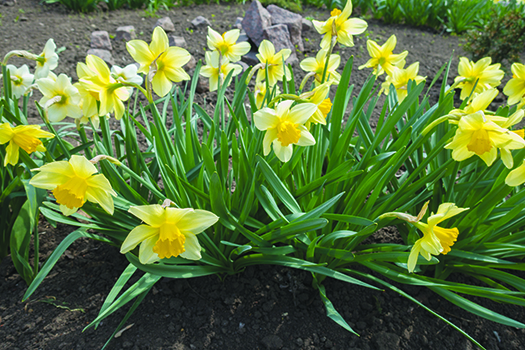
Daffodils and Jonquils will perennialize well by allowing the foliage to remain undisturbed until it has withered away.
Watch for Boxwood Twig Blight.
The fungus Cylindrocladium pseudonaviculatum first presents itself as leaf spot followed by rapid browning and leaf drop starting on the lower branches and moving upward in the canopy.
The fungus can remain in fallen leaves, so be sure to rake up fallen twigs and throw them away.Do not compost.
Research is still being conducted to find a solution to get rid of this fungus.
Ridding the plant of diseased branches and raking up all dropped leaves is the best prevention.
Week One
• Clean up all garden beds. Rake out and collect all unwanted debris — dead leaves, stems, old mulch, dried flower heads — anything that is not going to grow this year and won’t be used to create an organic layer in the garden.
Dispose of this debris in the trash — do not compost it as it could be harboring diseases and insect eggs.
• Prune and shape up crape myrtles you wish to grow as trees before they bloom.
Remove any dried flower clusters or seed pods.
To encourage a canopy to form, remove the branches a third of the way up the trunk.
Always remove any branches rubbing across others and any growing into the center of the canopy.
Always prune unbranched limbs back to an outward facing bud.
Also, remember crape myrtles are slow to wake-up in the spring.
If you feel that your plant has died, wait until late next month before deciding whether to replace it.
Week Two
• Finish tree and shrub pruning, but do not touch spring bloomers until flowers fade. You can prune evergreens until late summer. Do not prune later or new, tender growth will get zapped by winter cold.
• You will have bigger blooms and more of them if you fertilize your spring flowering bulbs after they are finished blooming.
I suggest using Espoma’s Bulb-tone at a rate of 4-6 pounds every 100 square feet.
Week Three
• To solve compaction of the lawn, avoid thatch buildup, and condition the soil, aerate every two or three years.
Aerating equipment punches 2- to 3-inch deep holes in the soil and allows fertilizer, air, and water to penetrate.
• Keep ornamental grasses looking good by cutting them down to nearly ground level before they start to sprout (don’t cut too low or you’ll damage the plant — don’t cut too high or the plant will look like it’s wearing a straw skirt).
Pruners will work on smaller grasses, hedge trimmers work well on larger ones, and for those in-between a sickle is a good option.
Week Four
• Do not be tempted to cut back the foliage off of your daffodils. The bulb uses the leaves to transform energy from the sun to help develop next year’s blossoms.
Leave until foliage has turned completely yellow.
Apply Bulb-tone as per label instructions now, to promote bigger and more flowers for next season.
• When mulching we suggest using a product called Amaze for prevention of both broadleaf and grassy weeds in the flowerbeds.
It is also a great time to apply any needed fertilizers such as Espoma’s Holly-tone or Plant-tone to provide extended feeding of the plants.
Be sure to apply all products before mulching to insure that they will stay in place.
Spring Flowering Bulb Care
• Daffodils and Jonquils will perennialize well by allowing the foliage to remain undisturbed until it has withered away.
Do not tie up or bind up the foliage, as doing so cuts off light and oxygen the bulbs need to nourish the flowers for next season.
• Allowing the foliage of tulips to yellow about halfway down before trimming them back will help to perennialize these bulbs and allow for proper nutrition.
• It is a good idea to feed all bulbs after bloom time, in order for the plants to achieve bigger and more blooms.
We suggest using Espoma’s Bulb-tone at the rate of 4-6 pounds per 100 square feet. Repeat this application again in early September.
• If you plan on moving or dividing bulbs, the best time to do so is after the foliage has died away. So as not to damage the bulb, use a flag or some other type of marker to show the exact location.
Be sure to move them before September to allow them time to root out properly before winter.
• Daffodils, narcissus, and Jonquils are safe from deer damage, but tulips and crocuses are not.
Use a deer repellent if this is a problem.
I recommend using liquid fence, you will get about 30 days of protection.
(Editor’s Note: Ken Morgan is the owner of Robin’s Nest Floral and Garden Center in Easton, Md.)



